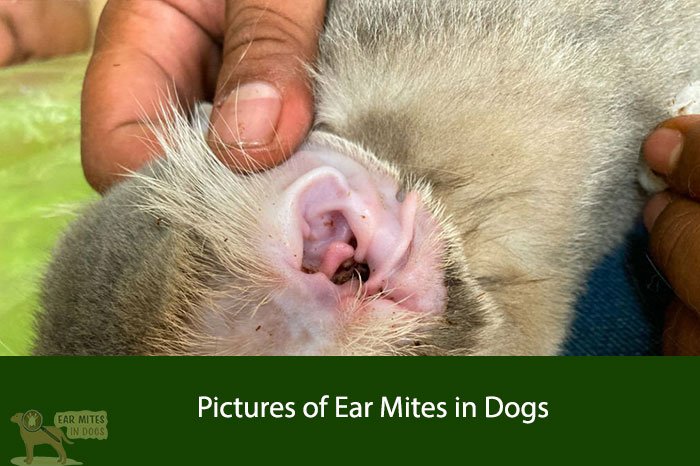Ear mites are a common problem among dogs and other pets. These tiny parasites can cause a range of symptoms, from mild irritation to severe infections. One of the most common signs of ear mites in dogs is the presence of dark, crumbly debris in the ear canal. This debris is often described as looking like coffee grounds and is made up of a combination of ear wax, dirt, and mites.
If you suspect that your dog may have ear mites, it’s important to have them examined by a veterinarian. A vet can confirm the diagnosis and recommend an appropriate treatment plan. In addition to examining your dog’s ears, the vet may also take a sample of the debris for testing. This can help to identify the specific type of mite that is causing the problem and ensure that the right treatment is used.
In this article, we’ll take a closer look at ear mites in dogs, including how to identify them, what symptoms to look out for, and how they can be treated. We’ll also provide pictures of ear mites in dogs to help you better understand what you’re dealing with. Whether you’re a pet owner or a veterinarian, this article will provide valuable information on this common and often frustrating problem.
Understanding Ear Mites in Dogs

Ear mites are a common parasitic infection that affects dogs of all ages and breeds. These tiny mites, also known as Otodectes cynotis, live in the ear canal and feed on the wax and oils in the ear. While ear mites are not usually life-threatening, they can cause severe discomfort and irritation to your dog’s ears.
What Are Ear Mites?
Ear mites are a type of mite that lives in the ear canal of dogs. They are highly contagious and can be easily transmitted from one dog to another through direct contact. Ear mites are more common in puppies and young dogs, but they can affect dogs of all ages.
Signs and Symptoms of Infestation
The most common signs of ear mite infestation in dogs include:
- Head shaking
- Scratching at the ears
- Redness and inflammation in the ear canal
- Dark, waxy discharge from the ears
- Strong odor coming from the ears
If you notice any of these symptoms in your dog, it is important to take them to the vet for a proper diagnosis and treatment.
The Life Cycle of Ear Mites
Ear mites have a life cycle of about three weeks. During this time, the mites go through several stages of development, including egg, larva, nymph, and adult. The adult mites lay eggs in the ear canal, which hatch into larvae and then develop into nymphs. The nymphs then mature into adult mites, and the cycle starts all over again.
Treating ear mite infestations in dogs usually involves a combination of medication and cleaning the ears. Your vet may prescribe ear drops or other medications to kill the mites, and you will need to clean your dog’s ears regularly to remove any debris or wax buildup.
Overall, ear mites can be a nuisance for dogs and their owners, but with prompt treatment, most dogs make a full recovery. If you suspect that your dog has an ear mite infestation, it is important to seek veterinary care as soon as possible.
Diagnosis of Ear Mites

Veterinary Examination
When a dog is suspected of having ear mites, the first step is to take them to a veterinarian. During the examination, the veterinarian will use an otoscope to examine the dog’s ear canal. Ear mites are tiny, so it can be difficult to see them with the naked eye. However, with the use of an otoscope, the veterinarian can easily identify the presence of ear mites in the ear canal.
Diagnostic Tests
In some cases, the veterinarian may also perform a diagnostic test to confirm the presence of ear mites. One common test is a microscopic examination of the ear discharge. The veterinarian will take a sample of the discharge and examine it under a microscope. Ear mites are easily identified under the microscope, as they have a distinctive shape and movement.
Another diagnostic test is a skin scraping. The veterinarian will take a small sample of skin from the ear canal and examine it under a microscope. This test can help identify any other possible causes of the dog’s symptoms, such as a bacterial or fungal infection.
In some cases, the veterinarian may also recommend a blood test to rule out any underlying health conditions that may be contributing to the dog’s ear mite infestation.
Overall, a veterinary examination and diagnostic tests are necessary to accurately diagnose ear mites in dogs. It is important to seek veterinary care as soon as possible if you suspect your dog has ear mites, as untreated infestations can lead to serious complications.
Treatment Options

When it comes to ear mites in dogs, there are several treatment options available. In this section, we will discuss the most common treatment options for ear mites in dogs, including medications and prescriptions, home remedies, and preventive measures.
Medications and Prescriptions
One of the most effective ways to treat ear mites in dogs is through the use of medications and prescriptions. Your veterinarian may prescribe a topical medication that you can apply directly to your dog’s ears. These medications typically contain insecticides that kill the ear mites and their eggs.
In addition to topical medications, your veterinarian may also prescribe oral medications. These medications are typically given to your dog once a day for several weeks. Oral medications are effective at killing both adult ear mites and their eggs.
Home Remedies
There are several home remedies that you can use to treat ear mites in dogs. One of the most common home remedies is to clean your dog’s ears with a mixture of vinegar and water. This can help to remove the ear mites and their debris from your dog’s ears.
Another home remedy is to use mineral oil. Simply apply a few drops of mineral oil to your dog’s ears and massage it in. This can help to smother the ear mites and prevent them from reproducing.
Preventive Measures
Preventing ear mites in dogs is important, especially if your dog has had ear mites in the past. One of the best ways to prevent ear mites is to keep your dog’s ears clean and dry. You should also inspect your dog’s ears regularly for signs of ear mites.
If your dog is prone to ear mites, your veterinarian may recommend a monthly preventative medication. These medications are typically applied topically and can help to prevent ear mites from taking hold.
In conclusion, there are several treatment options available for ear mites in dogs. Whether you choose to use medications and prescriptions, home remedies, or preventive measures, it is important to work with your veterinarian to develop a treatment plan that is right for your dog.
Visual Guide to Ear Mites

As pet owners, it’s important to keep an eye on our furry friends and their health. One common issue that dogs can face is an infestation of ear mites. These tiny parasites can cause discomfort and even lead to more serious problems if left untreated. In this section, we’ll provide a visual guide to help you identify ear mites in dogs and understand the stages of infestation.
Images of Ear Mites in Dogs
To start, let’s take a look at some pictures of ear mites in dogs. Ear mites are small, spider-like creatures that live in the ear canal and feed on the wax and oils produced by the skin. They can be difficult to see with the naked eye, but with the help of a magnifying glass or microscope, you can spot them easily. The images below show what ear mites look like up close:
Comparative Pictures
It’s important to note that ear mites can be easily confused with other types of parasites, such as ticks or fleas. To help you differentiate between them, we’ve included some comparative pictures below:
Stages of Infestation
Ear mites go through several stages of infestation, and each stage can have different symptoms. Here’s a breakdown of the stages:
- Early Infestation: In this stage, the ear mites have just started to multiply in the ear canal. Symptoms may include scratching, head shaking, and a dark, waxy discharge from the ear.
- Moderate Infestation: As the ear mites continue to multiply, symptoms become more severe. The dog may experience intense itching, redness and swelling in the ear, and a strong, unpleasant odor.
- Advanced Infestation: In the final stage, the ear mites have taken over the ear canal completely. The dog may experience hearing loss, balance problems, and even damage to the ear drum.
By identifying ear mites early on, you can prevent them from causing serious harm to your dog. Keep an eye out for the symptoms we’ve mentioned, and if you suspect your dog has ear mites, don’t hesitate to contact your veterinarian.
Aftercare and Monitoring

Follow-Up Care
After treatment for ear mites, it is important to follow up with your veterinarian to ensure that the mites have been completely eradicated. We may recommend a follow-up appointment to examine your dog’s ears and check for any signs of residual infection or inflammation. In some cases, additional treatment may be necessary.
We may also recommend cleaning your dog’s ears regularly to prevent future ear mite infestations. This can be done using a gentle ear cleaning solution and cotton balls or gauze. Be sure to follow our instructions carefully to avoid causing further irritation or injury to your dog’s ears.
Monitoring for Complications
While ear mites are generally not a serious health concern, they can lead to complications if left untreated. In rare cases, ear mite infestations can cause secondary infections or lead to more serious ear problems such as otitis externa or middle ear infections.
If you notice any signs of persistent or worsening inflammation, discharge, or discomfort in your dog’s ears, it is important to contact us immediately. We may recommend further testing or treatment to address any underlying issues and prevent complications from developing.
Overall, with proper follow-up care and monitoring, most dogs with ear mites can make a full recovery and avoid any long-term complications.
Prevention Strategies
Preventing ear mites in dogs is essential to avoid the discomfort and pain that they can cause. Here are some effective prevention strategies that we can implement:
Environmental Control
Keeping the dog’s environment clean is crucial in preventing ear mites. Regularly vacuuming and cleaning the dog’s bedding, toys, and other items can help eliminate any potential sources of ear mites. Additionally, we can limit the dog’s exposure to other animals that may have ear mites, especially if they are known to have an infestation.
Regular Cleaning Routines
Regularly cleaning the dog’s ears is an essential part of preventing ear mites. We can use a gentle ear cleaner recommended by our veterinarian to clean the dog’s ears once a week. It is important to avoid using cotton swabs or other objects that may damage the dog’s ear canal. Additionally, we can inspect the dog’s ears regularly for signs of ear mites, such as redness, swelling, or discharge.
By implementing these prevention strategies, we can help keep our dogs healthy and free from the discomfort of ear mites.
Impact on Canine Health
Ear mites are a common problem for dogs, and their impact on canine health can be significant. In this section, we will discuss the potential complications and long-term effects of ear mites in dogs.
Potential Complications
Ear mites can cause a range of complications in dogs. One of the most common is otitis externa, which is an inflammation of the external ear canal. This can cause itching, redness, and swelling, as well as a foul odor and discharge from the ear. If left untreated, otitis externa can lead to more serious complications, such as ear infections and hearing loss.
Another potential complication of ear mites is skin irritation and inflammation. This can lead to scratching and biting, which can cause further damage to the skin and increase the risk of infection. In severe cases, dogs may develop open sores or lesions, which can be painful and difficult to treat.
Long-Term Effects
If left untreated, ear mites can have long-term effects on a dog’s health. Chronic ear infections can lead to permanent damage to the ear canal and hearing loss. In addition, repeated exposure to ear mites can weaken a dog’s immune system, making them more susceptible to other infections and illnesses.
It is important to note that while ear mites can be a serious problem for dogs, they are also easily treatable. With proper veterinary care and regular cleaning, most dogs can make a full recovery from ear mites and avoid any long-term complications.
In conclusion, ear mites can have a significant impact on canine health if left untreated. It is important for dog owners to be aware of the signs and symptoms of ear mites and seek veterinary care as soon as possible. With proper treatment and care, most dogs can make a full recovery and avoid any long-term complications.
Frequently Asked Questions

What are the symptoms of ear mites in dogs?
Ear mites in dogs can cause a variety of symptoms, including persistent scratching or rubbing at the ears, head shaking, and a dark, waxy discharge from the ears. In some cases, dogs may also experience redness, swelling, or inflammation of the ears.
How can I distinguish between ear mites and ear wax in my dog?
While both ear mites and ear wax can cause a dark, waxy discharge from the ears, ear mites are typically accompanied by other symptoms such as persistent scratching or head shaking. If you suspect that your dog may have ear mites, it’s important to seek veterinary care for an accurate diagnosis.
What is the most effective treatment for ear mites in dogs?
The most effective treatment for ear mites in dogs typically involves a topical medication that is applied directly to the ears. Your veterinarian may also recommend cleaning your dog’s ears to remove any debris or buildup that may be contributing to the problem.
Are ear mites in dogs contagious to humans?
While ear mites in dogs are not typically considered a significant risk to human health, they can be transmitted from dogs to other pets in the household. It’s important to seek veterinary care for your dog if you suspect that they may have ear mites to prevent the spread of infection.
What immediate actions can I take to treat mites on my dog?
If you suspect that your dog may have ear mites, it’s important to seek veterinary care for an accurate diagnosis and treatment plan. In the meantime, you can help to soothe your dog’s symptoms by gently cleaning their ears with a mild, non-irritating cleanser and avoiding any activities that may exacerbate their discomfort.
Can products like NexGard be used to treat ear mites in dogs?
While products like NexGard are designed to prevent and treat fleas and ticks in dogs, they are not typically effective against ear mites. Your veterinarian can recommend a more appropriate treatment plan based on your dog’s individual needs.





